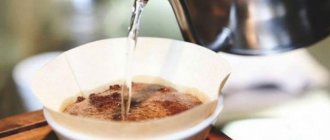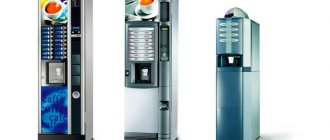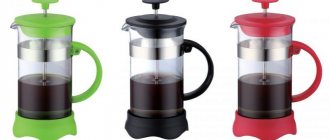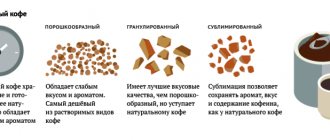The pace of modern life leaves less and less time to work magic on the Turk yourself. A variety of options for quickly preparing a natural drink has been replenished with coffee in individual use bags. Coffee in bags for brewing in a cup confidently claims to be a public favorite. How good is the noble drink in such packaging, who produces it, what are its pros and cons?
Types of bagged coffee
The idea of natural coffee in bags has been brewing for a long time and has taken shape in several versions.
- Single serving of finely ground coffee in a portion bag. This coffee needs to be poured from the bag into a cup and simply filled with water. We get natural coffee, but there are coffee grounds left in the cup, which are sometimes difficult to dispose of.
- Portioned coffee in closed filter bags with a thread holder. These bags are most similar to regular tea bags, only larger in size. They are placed in a cup and poured with boiling water, infused, and then removed.
- Coffee in specially designed bags. Its manufacturers took the path of improving packaging, which they called a drip pack, that is, a drip bag. It allows you to get a portion of natural coffee, well brewed, and at the same time, without any extraneous grounds in the cup. It is this version of portioned coffee that is gaining increasing popularity. Based on the name of the packaging, the drink was called drip coffee.
Drip coffee
Drip coffee is portioned coffee in a specially designed package that allows you to prepare a natural drink by pouring it and then removing the grounds from the cup. The name refers to the brewing method, not the type of coffee itself.
For packaging drip coffee, special multi-layer filter paper is used. It is made from natural cellulose, which is not subject to additional bleaching or other chemical influences. Therefore, contact of such paper with a drink is completely safe.
How it works?
Each serving of coffee is packed in foil. Cutting this package open, we see a square bag of filter paper. In the upper part there are folded elements made of thick cardboard. What actions should be taken next?
- Straighten the cardboard handles of the bag and pull them to the sides.
- The package will open to its full width. Coffee powder will be visible in it, and cardboard handles will stick out in different directions.
- Attach the handles to the cup, or rather, hook them to the opposite edges of the cup. The bag of coffee is locked open.
- Pour hot water into the coffee filter bag in a thin stream. Connoisseurs will see here an analogue with a pour-over, and this is indeed the case. Pour-over brewing technology inspired inventors to create coffee in bags.
When brewing drip coffee, the water must be poured slowly, without rushing. The approximate time for a 200 ml cup is at least a minute.
- Filled with hot water, the coffee must be left for 1-2 minutes.
- Then remove the cardboard handles of the bag from the edges of the cup, pull them and remove the bag of coffee grounds.
- The bag is no longer needed, it is disposed of, and you are left with a cup of hot, natural, strong coffee without any sediment.
This method gets its name from the English word drip, which means “drop”. The term rather refers to the method of preparing coffee, but it is already firmly attached to the packaging. Therefore, the name drip coffee can mean both a drink prepared by pouring and portioned coffee in specially designed bags.
How to brew correctly
Regular packaged coffee is brewed simply. To get the finished drink, you need to pour the contents of one sachet into a mug and pour boiling water into it. After 4-5 minutes you can enjoy the coffee taste and aroma.
It is no less easy to brew grains placed in special filter bags. The preparation procedure in this case is similar to brewing tea.
Ground coffee beans in paper packaging are placed in a cup, poured with boiling water and left to steep for 5 minutes.
Brewing coffee packed in drip bags deserves special attention. The procedure boils down to performing the following actions:
- Unpack the portion of ground beans placed in foil.
- Remove the square bag.
- The handles of the bag, made of cardboard, should be straightened and pulled to the sides.
- Attach cardboard handles to opposite edges of the mug.
- After this, pour boiling water into the filter bag in a thin stream. Take these steps slowly. It takes at least a minute to fill a 200 ml container.
- Infuse the drink for a couple of minutes.
- Take the bag by the cardboard handles, pull and thus remove it from the mug.
Ground coffee beans in bags are an opportunity to prepare your favorite drink in any conditions, and in a short period of time. Therefore, this type of product is becoming more and more popular. There are several types of packaging. Everyone can choose the option that suits them by studying each of the varieties and learning the intricacies of their use.
Types of single-serve coffee
Coffee in disposable bags can be of any type. Most often, manufacturers use a mixture of different grains.
- The inscription on the packaging of 100% Arabica means that a mixture of grains from different countries and even continents was used as raw materials.
- If robusta was used in the production of raw materials, then the proportion must be set, for example - Arabica 80%, Robusta - 20%. The higher the Robusta content, the stronger the coffee.
- The term "blend" also means a mixture, but it can contain coffee beans from the same territory or variety. For example, Kilimanjaro blend is a blend of coffee collected on African farms of the Kilimanjaro volcano, and Mocha blend is a mixture of Arabica beans from Yemen.
- If the packaging indicates the variety - Nicaragua Maragogipe or Tanzania Peaberry - then the ground coffee belongs to the single-origin class.
- Coffee without notes on the origin of the beans for raw materials is made from a very different mixture of beans and is considered low-grade.
Cost of coffee bags, where to buy, who produces
Coffee in drip bags
Its first producers were the Japanese. They were inspired by the pour-over method of brewing, popular in the Land of the Rising Sun. Other manufacturers borrowed the idea from the Japanese. In Russia, drip coffee is rapidly gaining popularity, and its own manufacturers are appearing.
- Coffee Yata . Several types of coffee are sold under this brand in filter bags. The assortment includes single-varietal varieties Cuba Turquino and Colombia Supremo, as well as blends from different parts of the world. The manufacturer of the brand is a Russian company. The cost of a package of 10 sachets of 8 grams is 250 rubles. That is, 100 grams of such coffee costs approximately 315 rubles, one serving costs 25 rubles.
- Blendy. It sells mainly blends of good Arabica coffee. The brand is of Japanese origin and is manufactured by the large concern AGF. The products are appreciated by domestic coffee lovers. The cost of a package of 8 sachets of 7 grams is 250 rubles. The cost of 100 grams of coffee is 445 rubles, and one cup is about 31 rubles.
- Brand . Another Russian manufacturer. He currently sells only one variety of coffee, Brazil Santos, at a cost of 350 rubles for 10 bags weighing 8 grams. 100 grams will cost 440 rubles, and one serving will cost 35 rubles.
- Coffesso . Trademark of the Russian manufacturer May. Sells Italian roasted Arabica beans. A package of 8 bags will cost from 230 rubles, that is, one serving – from 28 rubles.
Ground coffee in bags for one cup
Well-known brands are experimenting with such packaging, but, apparently, the format is not very popular.
- The Madeo brand offers individual servings for one cup at prices ranging from 320 to 550 rubles per pack of 10 pieces, which gives the cost per serving from 32 to 55 rubles.
- Lavazzo , a well-known European brand, some time ago also made an attempt to produce natural coffee for one cup. The cost was about 400 rubles for 10 sachets, but recently offers of this product have disappeared even from specialized stores.
Coffee in closed filter bags
They are produced by little-known and completely unknown manufacturers in our country, which, frankly speaking, do not inspire much confidence.
- Bestcoffee from Latvia offers bags at a price of 300 rubles per pack of 10 pieces. The origin of the grains is not specified. One bag contains 8 grams of ground powder.
- PHUONG Vy is a Vietnamese brand. Offers 100% Arabica under the name "Superb Morning". A package of 16 sachets costs 295 rubles. Brewing takes place for 3-5 minutes in hot water.
Even the mentioned manufacturers are difficult to find on supermarket shelves; they sell their products mainly through online stores.
It seems that drip coffee is winning the competitive race for now. It is preferred by manufacturers, buyers, and retail chains.
Coffee drips from Sibaristica
For drip packs, Sibaristica offers two of the most popular varieties with different acidities: Ethiopia Sidamo Guji and Brazil Cerrado Mineiro. The first, when brewed, gives the sweetness of flower honey and the pleasant acidity of tropical fruits, the second - chocolate, nuts and yellow apple.
We decided to make our own drip coffee because it is a simple, fast and convenient way to brew coffee. It is somewhat similar to alternative methods, and with it everyone can feel a little like a barista. In addition, we wanted to offer regular customers the opportunity to take coffee, the taste of which is almost indistinguishable from a filter, with them anywhere.
You can buy drips in the online store and in the coffee shop on Obvodny Canal.
Pros and cons of different types of coffee bags
What are the main pros and cons of coffee in different types of individual packaging.
Drip coffee
pros
- Ease of use.
- Efficiency of preparation. The process takes 2 minutes.
- No coffee grounds in the cup.
- Good quality natural drink.
- Mobility of drip packages. They can be used anywhere there is hot water.
- Compact packaging of each serving. You can take it with you or purchase the exact number of servings.
Minuses
- The cost of one serving is significantly higher than a cup of natural coffee brewed in the usual way. Coffee in drip packs costs from 25 to 35 rubles per serving. If you make coffee in a Turkish coffee pot or simply pour boiling water over coffee powder in a cup, the cost of a serving of a very decent quality drink ranges from 5 to 10 rubles. It turns out that drip technology increases the cost of a cup by 2.5-7 times.
- The need to control the brewing process. Filling the cup with hot water too quickly is not recommended. You need to pour the water quite slowly, then the coffee will release all its taste and aroma.
- There is still a small range of drip coffee in stores.
Individually packaged portioned ground coffee
pros
- Compact packaging
- Good quality drink
- Mobility of use
- Easy to prepare.
Minuses
- Presence of grounds in the drink
- The high price of a serving is from 30 rubles, which is 3-6 times higher than the exact same serving of coffee, but poured into a cup from a large bag, and even surpasses some types of drip coffee.
- Difficulty in purchasing. Individually packaged coffee is difficult to buy even in large supermarkets and its range is limited.
Portioned ground coffee in closed filter bags
pros
- Ease of use
- No grounds in the cup.
- Compact movement and storage
Minuses
- Low quality drink. This fact is noted by all users of this technology.
- High cost, comparable to the price of drip packages.
- Cooking duration. It will take twice as long to get a portion of the drink than a cup of drip coffee.
- Low level of distribution, difficult to find even in online trading.
Drip coffee: when did it appear and why is it convenient?
Drip-coffee (drip coffee or simply drips) is natural ground coffee, packaged in individual filter bags. It can be brewed directly in a cup: you only need hot water.
The technology for producing drip coffee was invented back in the 1990s. in Japan, but today it is only becoming more popular. First of all, because of the high speeds at which the modern world lives, and our desire to drink a quality drink at any time: while hiking, at work or at the dacha.
The drip bags that we are used to - with a cup attachment - were patented by the Japanese company UCC Ueshima Coffee back in 2001. The Japanese are workaholics and lovers of alternative brewing methods. But in Europe and America, “coffee in a cup” became popular much later. Today it occupies its special place between instant and grain. Over the past 20 years, manufacturers have come to packaging in a gas environment - using nitrogen, which preserves the taste; instead of ordinary paper, non-woven cellulose material is now used; Russian production; the use of specialty coffee and, most importantly, a rich taste.











